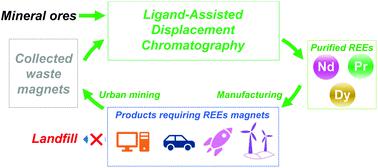当前位置:
X-MOL 学术
›
Green Chem.
›
论文详情
Our official English website, www.x-mol.net, welcomes your
feedback! (Note: you will need to create a separate account there.)
Two-zone ligand-assisted displacement chromatography for producing high-purity praseodymium, neodymium, and dysprosium with high yield and high productivity from crude mixtures derived from waste magnets
Green Chemistry ( IF 9.3 ) Pub Date : 2020-03-31 , DOI: 10.1039/d0gc00495b Yi Ding 1, 2, 3, 4 , David Harvey 1, 2, 3, 4 , Nien-Hwa Linda Wang 1, 2, 3, 4
Green Chemistry ( IF 9.3 ) Pub Date : 2020-03-31 , DOI: 10.1039/d0gc00495b Yi Ding 1, 2, 3, 4 , David Harvey 1, 2, 3, 4 , Nien-Hwa Linda Wang 1, 2, 3, 4
Affiliation

|
Three rare earth elements (REEs), neodymium (Nd), praseodymium (Pr), and dysprosium (Dy), are essential ingredients of permanent magnets, used widely in electronics, motors, hybrid cars, generators, televisions, sensors, and windmills. Conventional methods for producing high-purity REEs employ two-phase liquid–liquid extraction methods, which require thousands of mixer-settler units in series or in parallel and generate large amounts of toxic waste. In this study, a two-zone ligand-assisted displacement chromatography (LAD) system with a new zone-splitting method is developed for producing high-purity (>99%) Nd, Pr, and Dy with high yields (>99%) and high sorbent productivity from crude REE mixtures derived from waste magnets. The zone-splitting method based on selectivity-weighted composition factors enables a two-zone design to achieve two orders of magnitude higher productivity than that of a single column design. The design and simulation methods are based on first principles and intrinsic (or scale-independent) engineering parameters. They can be used to design processes for a wide range of feed compositions or production scales. The overall productivity of the two-zone LAD can exceed 100 kg REEs m−3 day−1, which is 100 times higher than those of the conventional extraction methods. The LAD for the purification of the ternary mixture requires only three chromatography columns, a safe extractant, EDTA, and other environmentally friendly chemicals. Most of the chemicals can be recycled, generating little waste. This method has the potential for efficient and environmentally friendly purification of the REEs from waste magnets. The method may also help transform the current linear REE economy (from ores to pure REEs, to products, to landfills) to a circular and sustainable REE economy.
中文翻译:

两区配体辅助置换色谱法,从废磁铁中提取的粗混合物高产率,高生产率地生产高纯度,钕和
三种稀土元素(REE),钕(Nd),ase(Pr)和(Dy)是永磁体的基本成分,广泛用于电子,电机,混合动力汽车,发电机,电视,传感器和风车中。生产高纯稀土元素的常规方法采用两相液-液萃取方法,这需要成千上万个串联或并联的混合沉降器单元,并产生大量有毒废物。在这项研究中,开发了一种具有新的区域拆分方法的两区配体辅助置换色谱(LAD)系统,可生产高纯度(> 99%)的高纯度(> 99%)Nd,Pr和Dy废磁铁产生的粗制稀土混合物可提高吸附剂的生产率。基于选择性加权组成因子的区域拆分方法使两区设计的生产率比单塔设计高出两个数量级。设计和仿真方法基于第一原理和内在(或与比例无关的)工程参数。它们可用于设计各种饲料组成或生产规模的工艺。两区LAD的整体生产率可以超过100 kg REEs m-3天-1,比传统提取方法高100倍。用于纯化三元混合物的LAD仅需要三个色谱柱,一个安全的萃取剂,EDTA和其他环保化学品。大多数化学物质可以回收利用,产生的废物很少。这种方法具有从废磁铁中高效,环保地净化稀土元素的潜力。该方法还可以帮助将当前的线性REE经济(从矿石到纯REE,再到产品,再到垃圾填埋场)转变为循环可持续的REE经济。
更新日期:2020-03-31
中文翻译:

两区配体辅助置换色谱法,从废磁铁中提取的粗混合物高产率,高生产率地生产高纯度,钕和
三种稀土元素(REE),钕(Nd),ase(Pr)和(Dy)是永磁体的基本成分,广泛用于电子,电机,混合动力汽车,发电机,电视,传感器和风车中。生产高纯稀土元素的常规方法采用两相液-液萃取方法,这需要成千上万个串联或并联的混合沉降器单元,并产生大量有毒废物。在这项研究中,开发了一种具有新的区域拆分方法的两区配体辅助置换色谱(LAD)系统,可生产高纯度(> 99%)的高纯度(> 99%)Nd,Pr和Dy废磁铁产生的粗制稀土混合物可提高吸附剂的生产率。基于选择性加权组成因子的区域拆分方法使两区设计的生产率比单塔设计高出两个数量级。设计和仿真方法基于第一原理和内在(或与比例无关的)工程参数。它们可用于设计各种饲料组成或生产规模的工艺。两区LAD的整体生产率可以超过100 kg REEs m-3天-1,比传统提取方法高100倍。用于纯化三元混合物的LAD仅需要三个色谱柱,一个安全的萃取剂,EDTA和其他环保化学品。大多数化学物质可以回收利用,产生的废物很少。这种方法具有从废磁铁中高效,环保地净化稀土元素的潜力。该方法还可以帮助将当前的线性REE经济(从矿石到纯REE,再到产品,再到垃圾填埋场)转变为循环可持续的REE经济。











































 京公网安备 11010802027423号
京公网安备 11010802027423号